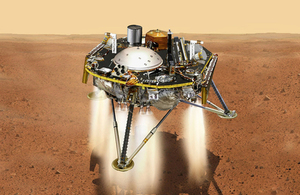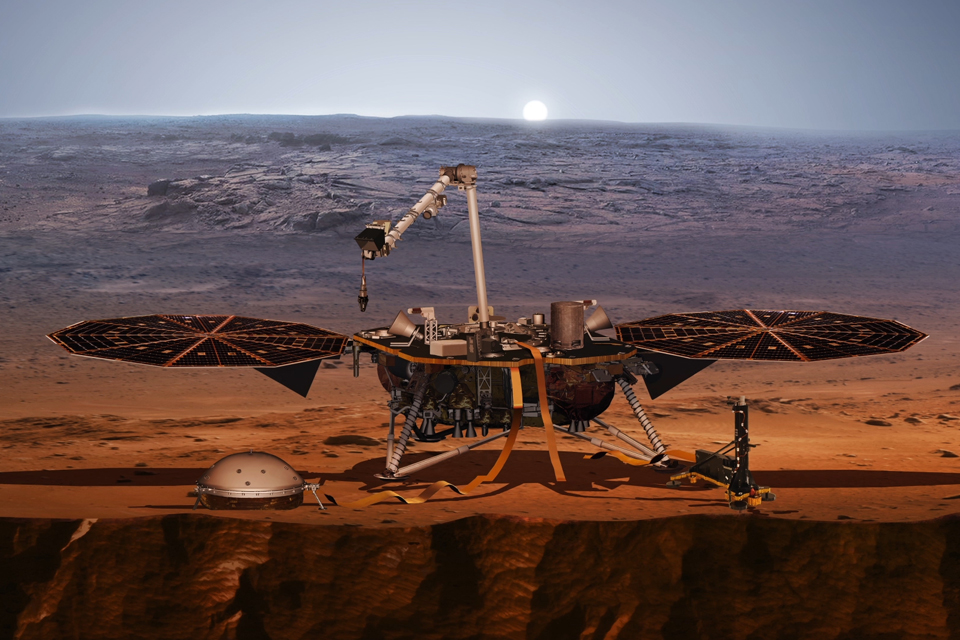A mission to Mars, supported by the UK Space Agency, has successfully landed and will soon begin the first study of the heart of the planet.

The NASA InSight mission landed at 19:53 GMT on Monday, 26 November.
InSight will study the inside of Mars to learn how planets, moons and meteorites with rocky surfaces, including the Earth and its Moon, formed. The lander's instruments include a seismometer to detect 'Marsquakes' and a probe to monitor the flow of heat beneath the surface of the planet.

The UK Space Agency has invested £4 million in the short period Seismometer (SEIS-SP). This will be on the surface of Mars to measure seismic waves from Marsquakes. Scientists expect to detect anywhere between a dozen and a hundred of these tremors up to 6.0 on the Richter scale over the course of two years.
Sue Horne, Head of Space Exploration at the UK Space Agency, said:
It is wonderful news that the InSight spacecraft has landed safely on Mars. The UK scientists and engineers involved in this mission have committed several years of their lives to building the seismometer on board, and the descent is always a worrying time. We can now look forward to the deployment of the instrument and the data that will start to arrive in the new year, to improve our understanding of how the planet formed.
InSight carries three instruments designed and built in the UK as part of the seismic package. These microseismometer sensors were developed by Imperial College London and integrated with electronics built by the University of Oxford.
The UK team is led by Professor Tom Pike at Imperial, who designed the sensors to withstand the shock and vibration of the launch from Earth and landing on Mars. The sensors can detect motion at sub-atomic scales with the help of the electronics built at Oxford under Dr Simon Calcutt, with support from STFC RAL Space.
Prof Tom Pike said:
We were able to turn on the microseismometers during the cruise to Mars and they performed perfectly, showing they survived the rigours of launch as they left Earth. But every landing on Mars is risky and we were waiting nervously at NASA's Jet Propulsion Laboratory (JPL) to get the first signal back from the successful landing.
The lander will take several weeks to deploy two of its three instruments, the seismometer and probe on to the Martian surface. The UK will have a team of instrument scientists from Imperial and Oxford at JPL in California to help with this process, including selecting just the right spot for the robot arm to deposit the seismometer.
Prof Pike added:
We should be listening for Marsquakes for at least two years, and we hope considerably longer. It is critical that we set down the instrument in the best place to ensure we're stable, and then follow up with adding a cover to shield our sensors from the wind.
The instrument team will be joined by UK seismologists from Bristol, led by Dr Nick Teanby, Imperial, led by Professor Gareth Collins, and Oxford led by Dr Neil Bowles, to analyse the data from all of the mission's instruments.
Dr Neil Bowles, from the University of Oxford's Department of Physics, said:
The InSight SEIS-SP seismometer is one of the most sensitive and challenging instruments we have worked on for spaceflight in Oxford. After launch in May and successful instrument checks during the cruise to Mars, the team are absolutely delighted to witness the landing. We've shown that a traditionally delicate scientific instrument is capable of being launched on a rocket and the next challenge is to see how it behaves on the surface of the planet.
With our partners at Imperial College London, STFC RAL Space and the UK Space Agency, getting the SEIS-SP seismometer assembled and qualified for flight has been a significant effort. After nearly a decade of preparation, building and testing we are incredibly excited that the science can now start.
The mission, which took off from California in May this year, will conduct six science investigations on and below the surface of Mars to uncover the evolutionary history that shaped all of the rocky planets in the inner solar system.
Anna Horleston, a researcher at Bristol University, said:
I've studied seismic data from all over the world but to get the chance to study data from Mars is just something else. To finally see it arrive and to get to test out our techniques on real Martian seismic data is so exciting.
The UK instrument will work together with seismometers from France, as well as major contributions from Switzerland, Germany and the US. Other instruments on board include RISE, a precision radio tracking of the lander that can determine the direction and motion of the rotation of Mars and the HP3 (Heat Flow and Physical Properties Probe) which will study heat flow by embedding a temperature sensor under the surface of Mars.






